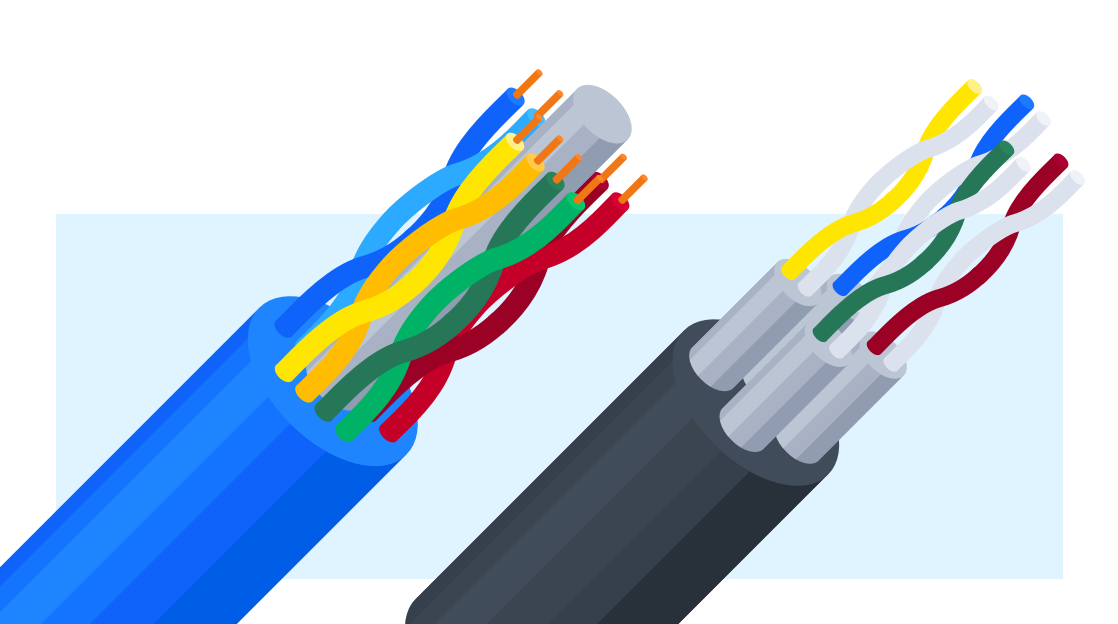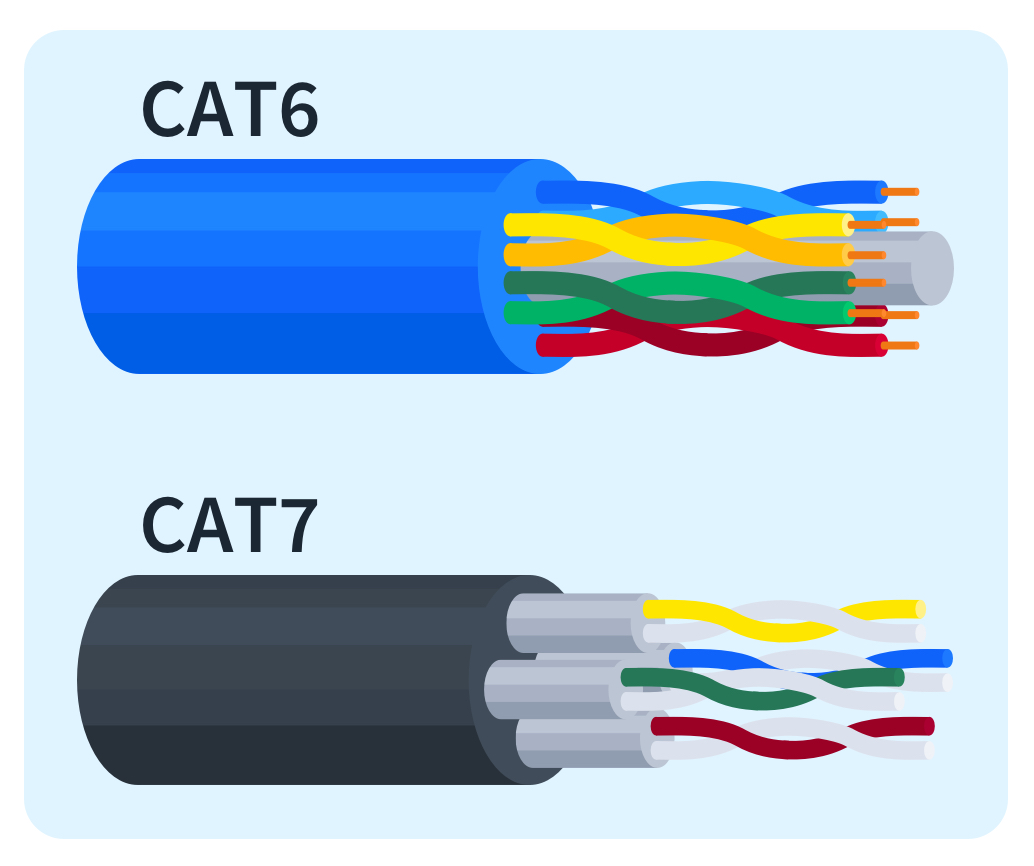Cat6 vs Cat7: What are the Differences?

Quick Definition: Cat6 Ethernet cables are an improvement over older Cat5 cables, offering faster speeds of up to 10Gbps and greater bandwidth that's suitable for modern gigabit networks. Cat7 goes a step further than Cat6, and adds individual shielding to reduce interference and support higher frequencies — enabling even faster speeds. While Cat6 is more cost-effective for most networks, Cat7 provides better future-proofing for high-speed and high-interference environments.
Ethernet cables all have eight wires in them, so they can’t be all that different, right? If you haven’t worked with Ethernet much or if you're studying for the Network+ exam, you'll discover there are many different standards, or categories (the Cat in Cat6 and Cat7). These categories specifically inform us about each cable type's features, maximum ratings, and frequencies.
Ethernet cable selection is not always as easy as it seems. Sometimes, jumping onto the newest standard is tempting, especially when each version promises improved performance and theoretical speeds.
Have you ever wondered about the difference between Cat6 and Cat7 cables? We'll untangle how factors like speed, shielding, and performance set them apart. Follow along as we decipher which cable is right for specific scenarios and if your existing networking equipment is up to the task.

What is Cat6?
Cat6 was a major leap forward from earlier Cat5 Ethernet cables. While still using 4 twisted pairs of copper wiring, Cat6 features stricter specifications to minimize interference and crosstalk, while offering greater speeds. Here are some of the key enhancements Cat6 provides over earlier standards:
Faster speed: Cat6 supports bandwidth up to 10Gbps, a major jump from Cat5e's 1Gbps. This allows Cat6 to handle modern gigabit networks without breaking a sweat.
Greater bandwidth: The increased bandwidth capacity of Cat6 enables bandwidth-hungry traffic on your networks for applications like 4K video streaming, 10GBASE-T networks, and Power over Ethernet (PoE).
Reduced crosstalk: Twists in the wiring are precisely optimized to limit electromagnetic interference between pairs of copper wires inside the Ethernet cable. This allows for more reliable transmissions with less interference.
Backward compatibility: A major plus is that Cat6 cables are backward compatible with earlier cable versions. This means that you can use it to replace Cat5 without full network upgrades to switches and other networking equipment.
As we can see, Cat6 delivers major improvements in speed, reliability, and performance compared to Cat5/5e cables. For networks needing to support over 1 gigabit speeds, Cat6 provides an affordable yet powerful wired cabling solution that can be done in incremental phases instead of revamping the entire infrastructure of a network at once.
What is Cat7?
Cat7 cables build on the performance of Cat6 cables by adding individual shielding to each twisted copper wire pair to further reduce crosstalk. Here are some of the key improvements Cat7 aims to provide:
Increased frequency support: Cat7 is specified for frequencies up to 600MHz, compared to 250MHz for Cat6. This higher frequency can theoretically enable network speeds above 10Gbps, but both Cat6 and Cat7 are rated as supporting 10GBASE-T. Replacing your Cat6 with Cat7 cable will not give you a speed increase without upgrading your networking equipment.
Enhanced crosstalk protection: The individual shielding around each wire pair is designed to minimize electromagnetic interference between cables. This helps prevent signal distortion and optimize transmission quality in high-interference areas.
Support for advanced 10G+ networks: The improved specifications make Cat7 suitable for high-speed 10GBASE-T networks and potentially faster-emerging standards. Real-world speeds will depend on factors like cable length and technological implementations of newer standards in the future.
Premium performance targets: Cat7 aims for the highest frequency, lowest crosstalk, and least signal error among common copper cable categories. It is well-suited for high-density networking environments where interference from other cables is likely.
Cat7 aims to push the boundaries of shielded twisted pair cabling performance beyond Cat6, but simply swapping out Cat6 with Cat7 will not give you a faster network. While both meet 10GBASE-T requirements, Cat7 provides theoretical headroom to handle the faster speeds of next-generation networking equipment. Its improved shielding also helps optimize robust signal transmission by reducing noise on the cable, which can help in high signal interference zones.
Cat6 Vs. Cat7: Speed and Bandwidth
When it comes to speed, both Cat6 and Cat7 technically support bandwidths up to 10Gbps, meeting the 10GBASE-T Ethernet standard. However, their maximum frequencies differ by quite a lot:
Cat6: 250MHz frequency that caps roughly at 10Gbps speed depending on cable length and interference.
Cat7: 600MHz frequency that can exceed 10Gbps speeds, again depending on the cable length and networking equipment.
This higher frequency gives Cat7 more headroom for faster speeds as faster networking technologies become more affordable and widely available. While Cat6 maxes out at around 10Gbps, Cat7 can theoretically exceed those speeds when paired with suitable network equipment.
For most modern office and data center networks, both cable types provide sufficient speed at 10Gbps. However, certain advanced applications like high-res security cameras, real-time industrial systems, and fast data transfers will benefit from the extra bandwidth of Cat7. Cat7’s shielding is also a huge deciding factor in certain situations where signal interference is a concern.
The increased cost of Cat7 makes it quite prohibitive for most networking budgets. The supporting network infrastructure makes it even more expensive, especially considering the full advantages of Cat7 don’t make sense for most networks.
If you are looking to run Cat7 cable yourself, make sure you have sufficient grounding for your network points. Keep in mind that its thicker diameter and added rigidity can make it quite unruly to pull through conduits and pipes.
Cat6 Vs. Cat7: Shielding and Interference
When it comes to blocking interference, Cat6 and Cat7 take different approaches:
Cat6 relies on the natural twisting of its copper wires to cancel out electromagnetic interference (EMI) between pairs, and has no shielding.
Cat7 adds individual shielding around each twisted pair, which prevents EMI and crosstalk for improved signal quality.
This shielding is the main advantage Cat7 provides over Cat6. The foil or braided mesh shield acts as a barrier, keeping electromagnetic fields from interfering between wire pairs.
Without shielded pairs, Cat6 cables are more susceptible to EMI and crosstalk, but standard cable runs that avoid high voltage and fluorescent lights are usually just fine. Keep in mind that too much interference can lead to slower speeds, data corruption, disconnects, and other network issues.
Cat6's unshielded design is sufficient for most modern networks with gigabit speeds. The basic twisting sufficiently minimizes crosstalk unless you're running Ethernet cables in dense bundles or high EMI environments.
Cat7's shielded pairs provide the most benefit in specialized settings like data centers, where cables are tightly packed and the extra protection optimizes reliability. To decide if the added cost is worth the extra investment, look at your network's susceptibility to interference versus the added cost of shielding to help you decide between Cat6 and Cat7.
Cat6 Vs. Cat7: Cost and Future-Proofing
When selecting Ethernet cabling, cost is often a major factor. Most network upgrade budgets are tightly managed, and the difference in pricing between Cat6 and Cat7 adds up. Generally speaking:
Cat6 cables are the most affordable option that is suitable for 10Gbps networks as pricing is similar to older Cat5e.
Cat7 cables can cost approximately 2 to 3 times more than Cat6 due to added shielding. The pricing can vary based on the manufacturer and other factors, but generally speaking, you will pay more for Cat7 than you will for Cat6 cable.
For many IT pros, Cat6 provides the ideal balance of fast 10Gbps speed at a relatively reasonable cost. Unless you specifically need capabilities above 10Gbps in the near future, Cat6 is likely the best value.
That said, Cat7 provides better future-proofing for growing bandwidth demands; Its extra shielding and higher frequency give it more headroom to handle speeds well over 10Gbps in cutting-edge data centers and networks.
Both cable types are backward compatible with earlier Ethernet standards, so you can mix Cat6 and Cat7 with Cat5e if you really have to. However, mixing standards can impact your network if your Ethernet switches can’t automatically account for the slower connections. Overall lifespan is similar, providing reliable connections for at least a decade with proper installation.
Evaluate your speed requirements and budget considerations. For most networks, Cat6 handles current and near-future needs at a friendly price point. But for state-of-the-art future-proofing, Cat7 is the top-tier choice.
Conclusion
Cat6 offers the ideal blend of fast 10Gbps speed and affordable pricing. But for specialized networks that need optimal performance at ultrafast 40G speeds, Cat7 is the superior choice, albeit at a greater cost.
To make the right choice for your network, you need to weigh up your speed requirements, bandwidth needs, interference susceptibility, and budget. With this overview of Cat6 vs Cat7, you now have a better idea of how to make the best cabling decision for your next network upgrade.
Want to take a deeper dive into cabling and networking infrastructure? Check out our CompTIA Network+ Certification Training. This comprehensive video course covers key concepts like wiring standards, cable types, network hardware, topologies, and more.
Whether you need a refresher on Cat5/6/7 cabling or want to learn network fundamentals from the ground up, this training has you covered. Sign up for a free 7-day trial and get access to the full Network+ course library plus hundreds of other resources as you prepare for IT certifications and enhance your networking skills!
delivered to your inbox.
By submitting this form you agree to receive marketing emails from CBT Nuggets and that you have read, understood and are able to consent to our privacy policy.